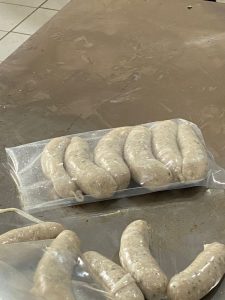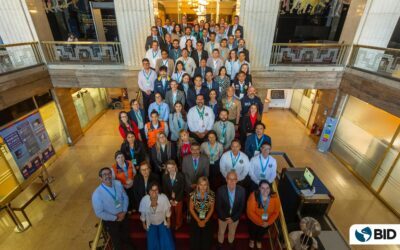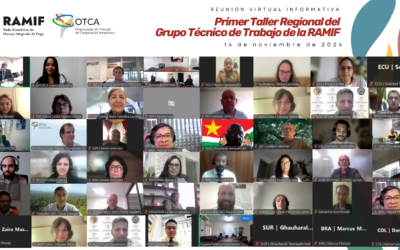Bolivia presented the improvement of Bolivia’s National Biodiversity Information System (SINB) and its interconnection with other systems, including the CITES Electronic Permit System.
Bolivia hosted the official mission of Bioamazon Project from September 19 to 24. It was the last of the eight ACTO Member Countries to receive the Bioamazon Project team for a dialogue on the results of the Project’s implementation and to become acquainted with the Amazon Regional Observatory, in detail. A field visit was also organized to learn about the work of the Matusha Aidha Association with the management and use of the alligator (Caiman yacare).
Representatives of the institutions involved in the execution of the Bioamazon Project and the ARO implementation participated in the opening meeting, held at the offices of the Vice-Presidency of the Plurinational State of Bolivia, namely: Ministry of Environment and Water (MMAYA), National Museum of Natural History (MNHN), National Service of Meteorology and Hydrology (SENAMHI), Social Control of Forests and. Land Authority and GeoBolivia.
Marcelo Zaiduni, director of GeoBolivia, welcomed the visit of the Bioamazon Project team, and recognized the value of the visit for the opportunity to learn firsthand ACTO’s developments within the framework of the Amazon Regional Observatory (ARO). GeoBolivia is an initiative of the vice-presidency of the Plurinational State, to provide relevant, harmonized and quality geographic information to institutions and users in general, in order to support the social, economic, and environmental development of the country.
Mauro Ruffino, Coordinator of the Bioamazon Project and the ARO, expressed his gratitude to the Director of GeoBolivia for the inter-institutional coordination provided for the meeting. Subsequently, the “ARO Workshop” was held, in which different presentations were made covering aspects of the historical development process, conceptual aspects, tools and procedures, interoperability mechanisms, among others.
In addition, videos of the CITES, Biodiversity and Forestry modules were presented. During the question and answers session, congratulations were given to ACTO for the work carried out with the implementation of the ARO.
During the afternoon session, a meeting “Bioamazon Project Workshop” was held at the premises of the Ministry of Environment and Water (MMAYA), to review the progress and effectiveness of the implementation of the activities of the Project’s three components. The meeting was attended by the Vice-Minister of Environment, Biodiversity, Climate Change and Forestry Management and Development, Magin Herrera López, and the Director General of Biodiversity and Protected Areas (DGBAP) and Project Focal Point, Omar Sharif Yumaa, as well as technicians from the DGBAP, the General Directorate of Forestry Management and Development (DGGDF) and the National Museum of Natural History (MNHN). Mr. Rodrigo Aguilar from GeoBolivia also attended the meeting.
Henry Taby, from Seth Solution, a consulting firm of MMAYA, presented the progress made in improving Bolivia’s National Biodiversity Information System (SINB) and its interconnection with other systems, including the CITES Electronic Permit System (https://citesbolivia.mmaya.gob.bo/).
Field Trip
Thursday, September 22, the Bioamazon Project team traveled to San Buenaventura, province of Abel Iturralde, department of La Paz, to get acquainted with the management and exploitation experience of the alligator (Caiman yacare) of the Tacana Indigenous Peoples by the Matusha Aidha Alligator Handlers’ Association. Among those participating in the event were the Bolivian Ministry of Environment and Water (MMAyA), the National Protected Areas Service (SERNAP), the Rurrenabaque and San Buenaventura governments, the Indigenous Council of the Tacana People, as well as representatives of the Ese Ejja Indigenous People of the Eyiyoquibo community and the Wildlife Conservation Society (WCS).
The Matusha Aidha Association explained how the alligator (Caiman yacare) is managed and exploited, as well as described their experiences during 15 years of work, such as the study on biology, crop monitoring, the technical regulations for the use of alligator meat (mobile slaughtering machine) for the National Agricultural Health and Food Safety Service (SENASAG); and the transformation of alligator meat derivatives (chorizos – alligator sausage). Such activities contribute to biodiversity conservation by maintaining stable alligator populations, indigenous territorial management, and also generate economic benefits for the communities of the Tacana Indigenous People, improving their quality of life.
Participants had the opportunity to learn about the processing of alligator meat for sausage production, whose equipment was acquired through the Bioamazon Project.
The Matusha Aida Association explained the use of second-rate alligator meat from the arrival of the meat to the vacuum-packed product for marketing, adding value with all the required quality assurance measures. Besides encouraging the communities to take care of the alligator, it is also a source of income that aims to improve the quality of life of the people who carry out this work.
“We are pleased to see the work of the Matusha Aida Association and to confirm that the support of the Bioamazon Project was very important for this community through the purchase of the equipment, with funds from the German financial cooperation through the KfW,” said Mauro Ruffino.




With information from GeoBolivia (source: https://geo.gob.bo/portal/#map).
Published in the Bioamazon Newsletter, issue n. 17, September- October 2022.
==================================================================











